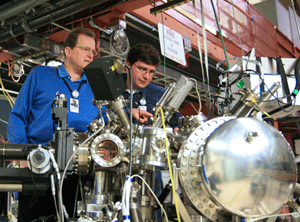Home > Press > The March of the Carbon Nanotubes
 |
| Anders Nilsson and Anton Nikitin at the beam line. |
Abstract:
Stanford Synchrotron Radiation Laboratory (SSRL) researchers have surpassed by a surprising margin the Department of Energy's goal for storing hydrogen within a unique material called carbon nanotubes. The pioneering result, published in the American Chemical Society's Nano Letters, brings us one step closer to realizing hydrogen as a source of energy.
The March of the Carbon Nanotubes
Menlo Park, CA | Posted on March 4th, 2008"We are trying to find a way to make hydrogen-power affordable," graduate student Anton Nikitin said. "Current vehicle prototypes cost over two million dollars. Sustainable developments will rise only from examining this problem piece by piece."
Hydrogen - the most abundant element in the universe - is an attractive carrier of renewable energy. It can be used in fuel cells to produce electricity, with the only byproduct being water. However, developing safe and efficient methods of storing hydrogen remains a challenge.
Current methods for storing hydrogen are expensive and inefficient. Storing hydrogen in tanks made from costly composite materials requires dangerously high pressures of up to 10,000 pounds per square inch. Compressing hydrogen is expensive, and the energy required outweighs the benefits.
Nikitin and his colleagues were able to pack seven percent by weight hydrogen into carbon nanotubes through the formation of bonds with carbon atoms. The chemically grown nanotubes are made of pure carbon and have walls a single atom thick. Because single-walled nanotubes are essentially all surface area, they can theoretically store an enormous proportion of hydrogen, making it a promising storage medium.
Demand for carbon nanotubes - in fields ranging from electronics to medicine - adds to the excitement surrounding this material, but don't expect hydrogen energy to appear overnight. Associate Professor Anders Nilsson estimates that it will be 20 years before all of the pieces come together.
"The world is possibly facing the biggest challenge of modern civilization," Nilsson said, "and science plays a pivotal role in developing a long-term solution."
####
For more information, please click here
Contacts:
Anders Nilsson
Anton Nikitin
Copyright © Stanford Synchrotron Radiation Laboratory (SSRL)
If you have a comment, please Contact us.Issuers of news releases, not 7th Wave, Inc. or Nanotechnology Now, are solely responsible for the accuracy of the content.
| Related News Press |
News and information
![]() Researchers develop molecular qubits that communicate at telecom frequencies October 3rd, 2025
Researchers develop molecular qubits that communicate at telecom frequencies October 3rd, 2025
![]() Next-generation quantum communication October 3rd, 2025
Next-generation quantum communication October 3rd, 2025
![]() "Nanoreactor" cage uses visible light for catalytic and ultra-selective cross-cycloadditions October 3rd, 2025
"Nanoreactor" cage uses visible light for catalytic and ultra-selective cross-cycloadditions October 3rd, 2025
Nanotubes/Buckyballs/Fullerenes/Nanorods/Nanostrings
![]() Enhancing power factor of p- and n-type single-walled carbon nanotubes April 25th, 2025
Enhancing power factor of p- and n-type single-walled carbon nanotubes April 25th, 2025
![]() Chainmail-like material could be the future of armor: First 2D mechanically interlocked polymer exhibits exceptional flexibility and strength January 17th, 2025
Chainmail-like material could be the future of armor: First 2D mechanically interlocked polymer exhibits exceptional flexibility and strength January 17th, 2025
![]() Innovative biomimetic superhydrophobic coating combines repair and buffering properties for superior anti-erosion December 13th, 2024
Innovative biomimetic superhydrophobic coating combines repair and buffering properties for superior anti-erosion December 13th, 2024
Discoveries
![]() Researchers develop molecular qubits that communicate at telecom frequencies October 3rd, 2025
Researchers develop molecular qubits that communicate at telecom frequencies October 3rd, 2025
![]() Next-generation quantum communication October 3rd, 2025
Next-generation quantum communication October 3rd, 2025
![]() "Nanoreactor" cage uses visible light for catalytic and ultra-selective cross-cycloadditions October 3rd, 2025
"Nanoreactor" cage uses visible light for catalytic and ultra-selective cross-cycloadditions October 3rd, 2025
Announcements
![]() Rice membrane extracts lithium from brines with greater speed, less waste October 3rd, 2025
Rice membrane extracts lithium from brines with greater speed, less waste October 3rd, 2025
![]() Researchers develop molecular qubits that communicate at telecom frequencies October 3rd, 2025
Researchers develop molecular qubits that communicate at telecom frequencies October 3rd, 2025
![]() Next-generation quantum communication October 3rd, 2025
Next-generation quantum communication October 3rd, 2025
![]() "Nanoreactor" cage uses visible light for catalytic and ultra-selective cross-cycloadditions October 3rd, 2025
"Nanoreactor" cage uses visible light for catalytic and ultra-selective cross-cycloadditions October 3rd, 2025
Energy
![]() Sensors innovations for smart lithium-based batteries: advancements, opportunities, and potential challenges August 8th, 2025
Sensors innovations for smart lithium-based batteries: advancements, opportunities, and potential challenges August 8th, 2025
![]() Simple algorithm paired with standard imaging tool could predict failure in lithium metal batteries August 8th, 2025
Simple algorithm paired with standard imaging tool could predict failure in lithium metal batteries August 8th, 2025
|
|
||
|
|
||
| The latest news from around the world, FREE | ||
|
|
||
|
|
||
| Premium Products | ||
|
|
||
|
Only the news you want to read!
Learn More |
||
|
|
||
|
Full-service, expert consulting
Learn More |
||
|
|
||








